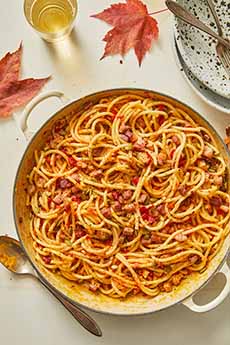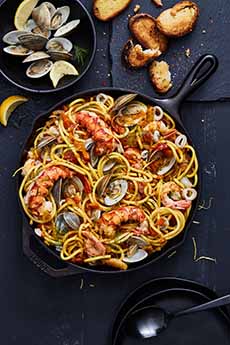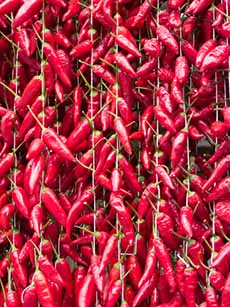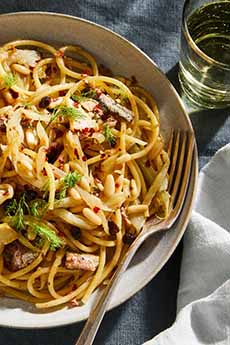PASTA RECIPE: Spicy Pumpkin Carbonara With Calabrian Chiles
|
|
Our friend Penny, who does not like mushrooms, felt “left out” when she saw our Creamy Mushroom Fettuccine recipe last week. So here’s one for Penny, for all mushroom-eschewers, for the pumpkin-happy fall, and for for National Pasta Month, October. In this recipe, “spicy” means hot, from the Calabrian chiles (photos #5 and #6). If you don’t want the heat, just omit them. Or, check out the bucatini recipes in photos #7, #8 and #9. Thanks to Delallo for the recipe. This recipe uses bucatini, a cut we love. Bucatini is a long, thick spaghetti-like pasta with a hole running through the center. It’s a tubular pasta, kin to cannelloni, elbows, penne, rigatoni and ziti. The name comes from the Italian buco (BOO-koe), meaning hole. The Neapolitans* call it perciato, which means pierced. Either way, it’s a fun cut. Why is it fun? Because you can suck the sauce through the straw. It’s messy, but you don’t have to be a kid to try it (at least once). Why the hole? One reason for the hole is that, in the days when all pasta was made by hand, it enabled a thicker version of spaghetti to cook more evenly, so the inside would not still be hard when the outside was al dente. Popular preparations there use: Ingredients For 4 Servings 1. BEAT the eggs, cheese, pumpkin and nutmeg in a large serving bowl, until combined. Add the salt and pepper. Set aside, and bring 5 quarts of salted water to a boil. 2. HEAT the olive oil and garlic in a large saucepan. Once the garlic begins to turn golden, remove from the oil and discard. Add the pancetta to the pan. Sauté the pancetta until it becomes golden brown, about 6 minutes. Then add chiles to the pan and cook until fragrant, about 2 minutes. 3. COOK the pasta according to package instructions. Drain, reserving 2 cups of the pasta water to finish the sauce. 4. COMBINE the hot pasta and pancetta mixture with oil in the serving bowl with the egg and cheese. Toss to coat and to gently cook the eggs, which is done with the heat of the pasta. Once combined, add about 1/4 cup of the reserved hot pasta water and toss. If the pasta appears too dry, add another splash of pasta water. 5. SERVE immediately, with additional parmesan cheese to garnish. Calabrian chiles (or chili peppers) are a variety of native to the Calabria region of Italy (the toe of the “shoe”—the heel is in Apulia). They are also called the small red cherry pepper, devil’s kiss and peperone picante Calabrese, which means “spicy pepper of Calabria.” The typical harvesting season is late summer through fall. Their genus and species, Capsicum annuum, is the same one for bell peppers, sweet/Italian peppers, serrano, cayenne, paprika, and jalapeños. (There are five different Capsicum cultivars.) Depending on your personal definition of “hot,” Calabrian chiles are moderately hot or hot, ranging from 25,000 to 40,000 SHU on the Scoville Scale. Hot peppers are in the 30,000 to 50,000 SHU range. By comparison, a jalapeño ranges from 2,500–8,000 SHU. The chiles are blood-red and small but very flavorful, soaking up more than 300 days of sunshine annually. This means that in addition to heat, they have a flavor unique to their terroir: fruity, salty and smoky. These popular chiles—a staple in southern Italy—are sold fresh, but also dried, pickled, or stuffed and sold in olive oil. DeLallo Foods, an importer of fine Italian foods, sells them that way, ready to use in a recipe or as part of an antipasto. Diamante, a coastal town at the top of Calabria (above the “ankle” of the foot, close to the border with Basilicata), holds an annual Peperoncino Festival. The weeklong event takes place every September (in a non-pandemic year) and lasts a week. It attracts visitors from all over the world. Calabrian chiles can be served both raw and cooked: baked, roasted and sautéed. They pair well with just about anything: cheeses, fish and shellfish, herbs (basil, cilantro, mint, parsley, ), meats (beef, poultry, pork), and vegetables (cucumbers, mushrooms, tomatoes, zucchini). You can also use them to stuff olives. Fresh chiles will keep up to one week when stored whole and unwashed in the fridge, in a paper or plastic bag. The fresh chiles are: Chiles were first introduced to Italy by Spanish traders, likely in the early 16th century. Columbus had brought seeds back to Spain from the Caribbean in 1493. These members of the Nightshade** family, were initially met with suspicion, and were mainly used for decoration until they were deemed safe to consume (the same happened with tomatoes, also brought back from the New World, and also Nightshades**). Then, chiles were quickly adopted into Italian cuisine, and many new varieties were cultivated in Italy. As mentioned earlier, terroir‡‡ had a big influence on the diverse flavors, sizes, etc. Today, outside of Italy, Calabrian chiles are predominantly grown by small growers in Asia, Australia, Europe and the U.S. If you’d like to grow them at home, you can find seeds online [source]. |
|
|
________________ *Neapolitans are residents of Naples, Italy. Neapolitan is the language of Naples, and also the name of a species of dog and horse bred in the region, among other references. †Rome is not only the capital of the country of Italy, but the capital of the Province of Rome, and the capital of the region of Lazio. ‡In the U.S., you can find fresh Calabrian chiles from California; but also dried or jarred versions and Calabrian chile oil. Some stores refer to them as peperoncini, the generic Italian word for hot chiles (singular peperoncino, both cases often spelled with a double “p” in the U.S.). The generic name for sweet chile peppers in Italian is peperoni (singular peperone). If you can’t find Calabrian chiles, you can substitute serrano chiles, crushed red pepper flakes or a hot chile paste like aji amarillo, harissa or sambal olek. ‡‡Terroir, pronounced tur-WAH, is a French agricultural term referring to the unique set of environmental factors in a specific habitat that affect a crop’s qualities. It includes climate, elevation, proximity to a body of water, slant of the land, soil type and amount of sun. These environmental characteristics gives a fruit or vegetable its unique character. **The Nightshade family, Solanaceae, is a family of flowering plants. Many of their fruits, pods or roots are edible, while others contain the alkaloid solanine, which is toxic in high concentrations (as in the deadly nightshade, or belladonna, and the tobacco plant). Edible members include the cape gooseberry, capsicum (chile), eggplant, goji berry, potato, tamarillo and tomatillo and tomato, among others.
|
||








